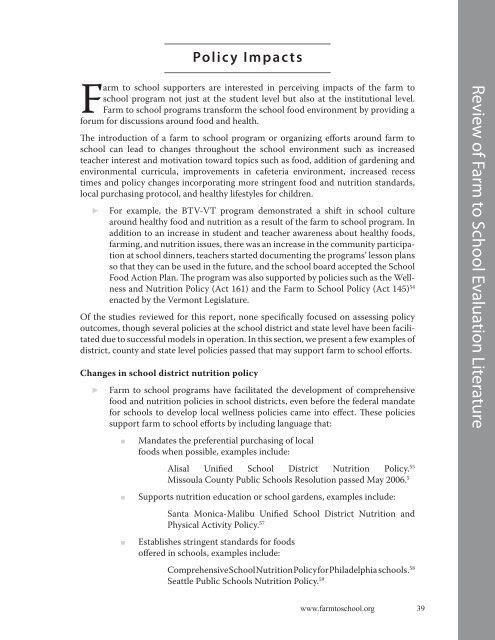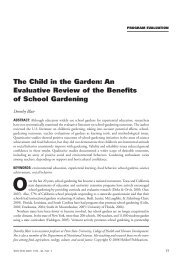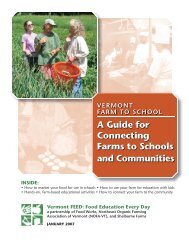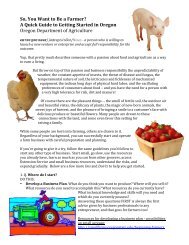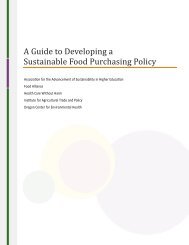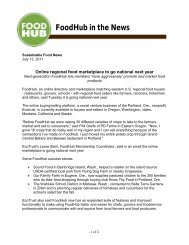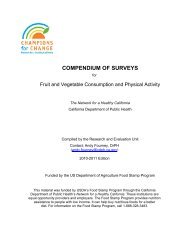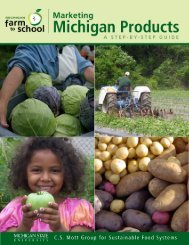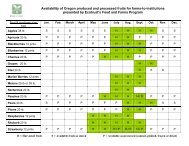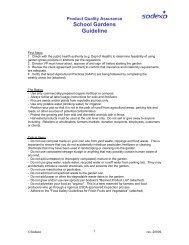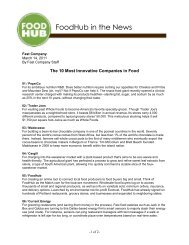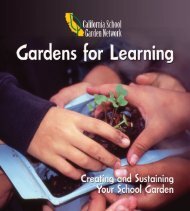eval report cover.indd - New Jersey Farm to School Network Wiki
eval report cover.indd - New Jersey Farm to School Network Wiki
eval report cover.indd - New Jersey Farm to School Network Wiki
You also want an ePaper? Increase the reach of your titles
YUMPU automatically turns print PDFs into web optimized ePapers that Google loves.
Policy Impacts<strong>Farm</strong> <strong>to</strong> school supporters are interested in perceiving impacts of the farm <strong>to</strong>school program not just at the student level but also at the institutional level.<strong>Farm</strong> <strong>to</strong> school programs transform the school food environment by providing aforum for discussions around food and health.Th e introduction of a farm <strong>to</strong> school program or organizing efforts around farm <strong>to</strong>school can lead <strong>to</strong> changes throughout the school environment such as increasedteacher interest and motivation <strong>to</strong>ward <strong>to</strong>pics such as food, addition of gardening andenvironmental curricula, improvements in cafeteria environment, increased recesstimes and policy changes incorporating more stringent food and nutrition standards,local purchasing pro<strong>to</strong>col, and healthy lifestyles for children.►For example, the BTV-VT program demonstrated a shift in school culturearound healthy food and nutrition as a result of the farm <strong>to</strong> school program. Inaddition <strong>to</strong> an increase in student and teacher awareness about healthy foods,farming, and nutrition issues, there was an increase in the community participationat school dinners, teachers started documenting the programs’ lesson plansso that they can be used in the future, and the school board accepted the <strong>School</strong>Food Action Plan. The program was also supported by policies such as the Wellnessand Nutrition Policy (Act 161) and the <strong>Farm</strong> <strong>to</strong> <strong>School</strong> Policy (Act 145) 54enacted by the Vermont Legislature.Of the studies reviewed for this <strong>report</strong>, none specifi c ally focused on assessing policyoutcomes, though several policies at the school district and state level have been facilitateddue <strong>to</strong> successful models in operation. In this section, we present a few examples ofdistrict, county and state level policies passed that may support farm <strong>to</strong> school efforts.Changes in school district nutrition policy►<strong>Farm</strong> <strong>to</strong> school programs have facilitated the development of comprehensivefood and nutrition policies in school districts, even before the federal mandatefor schools <strong>to</strong> develop local wellness policies came in<strong>to</strong> effect. These policiessupport farm <strong>to</strong> school efforts by including language that:■Mandates the preferential purchasing of localfoods when possible, examples include:Review of <strong>Farm</strong> <strong>to</strong> <strong>School</strong> Evaluation LiteratureAlisal Unified <strong>School</strong> District Nutrition Policy. 55Missoula County Public <strong>School</strong>s Resolution passed May 2006. 5■■Supports nutrition education or school gardens, examples include:Santa Monica-Malibu Unifi e d <strong>School</strong> District Nutrition andPhysical Activity Policy. 57Establishes stringent standards for foodsoffered in schools, examples include:Comprehensive <strong>School</strong> Nutrition Policy for Philadelphia schools. 58Seattle Public <strong>School</strong>s Nutrition Policy. 59www.farm<strong>to</strong>school.org 39


